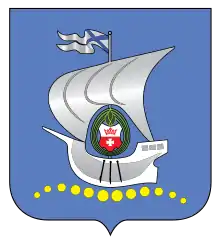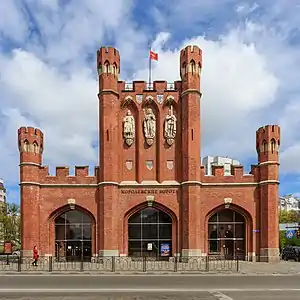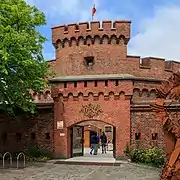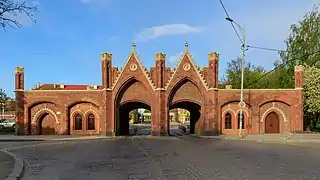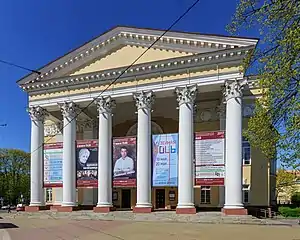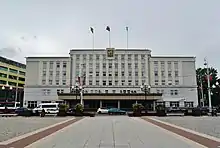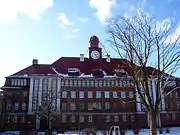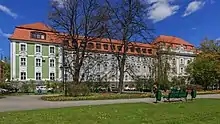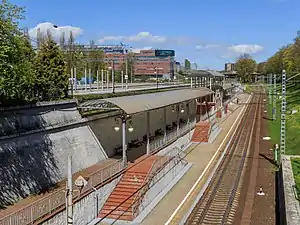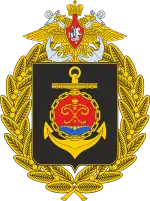Kaliningrad
Kaliningrad (Russian: Калининград, IPA: [kəlʲɪnʲɪnˈɡrat]; historically German: Königsberg, Polish: Królewiec and Old Prussian: Twangste) is the largest city and the administrative centre of Kaliningrad Oblast, the westernmost Oblast of Russia.[12] The city is situated on the Pregolya River, at the head of the Vistula Lagoon on the Baltic Sea, with a population of 489,359 residents,[13] up to 800,000 residents in the urban agglomeration.[14][15] Kaliningrad is the second-largest city in the Northwestern Federal District, after Saint Petersburg, the third-largest city in the Baltic region, and the seventh-largest city on the Baltic Sea.
Kaliningrad
Калининград | |
|---|---|
City[1] | |
.png.webp) Church of the Holy Family; Königsberg Cathedral; "Fishermen's village" in pseudo-historic style; Brandenburg Gate; King's Gate; Pregolya River | |
 Flag | |
| Anthem: none[2] | |
Location of Kaliningrad 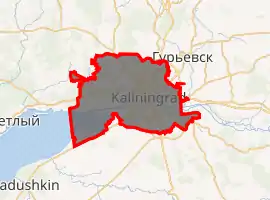
| |
 Kaliningrad Location of Kaliningrad .svg.png.webp) Kaliningrad Kaliningrad (European Russia) 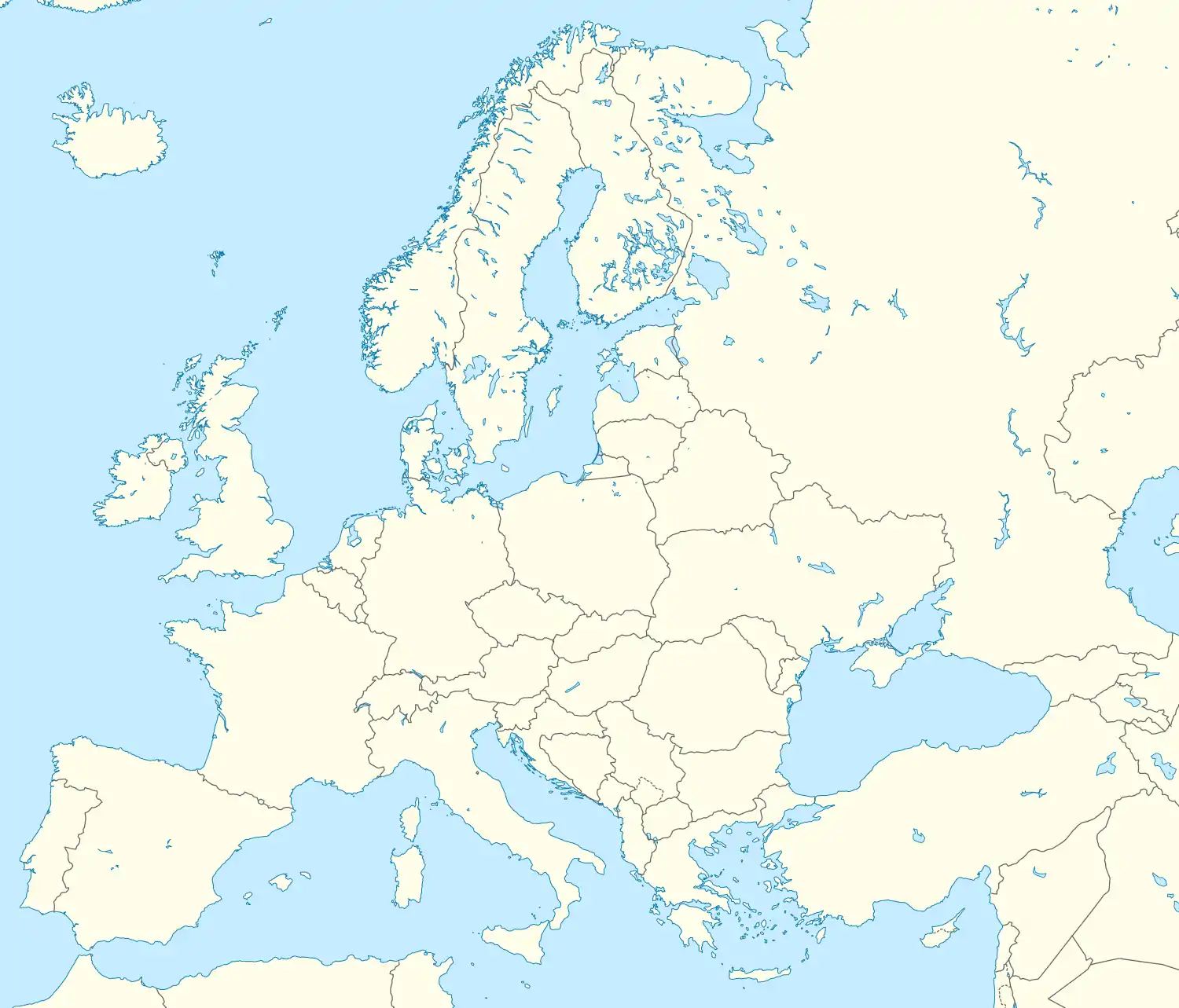 Kaliningrad Kaliningrad (Europe) | |
| Coordinates: 54°42′01″N 20°27′11″E | |
| Country | Russia |
| Federal subject | Kaliningrad Oblast[1] |
| Founded | 1 September 1255[3] |
| Government | |
| • Body | City Council of Deputies[4] |
| • Head[4] | Alexey Silanov[5] |
| Area | |
| • Total | 223.03 km2 (86.11 sq mi) |
| Elevation | 5 m (16 ft) |
| Population | |
| • Total | 431,402 |
| • Estimate (2018)[7] | 475,056 (+10.1%) |
| • Rank | 40th in 2010 |
| • Density | 1,900/km2 (5,000/sq mi) |
| • Subordinated to | city of oblast significance of Kaliningrad[1] |
| • Capital of | Kaliningrad Oblast[8], city of oblast significance of Kaliningrad[1] |
| • Urban okrug | Kaliningrad Urban Okrug[9] |
| • Capital of | Kaliningrad Urban Okrug[9] |
| Time zone | UTC+2 (MSK–1 |
| Postal code(s)[11] | 236001 - 236999 |
| Dialing code(s) | +7 4012 |
| OKTMO ID | 27701000001 |
| City Day | 4 July; observed on the first Saturday of July |
| Website | www |
The settlement of modern-day Kaliningrad was founded in 1255 on the site of the ancient Old Prussian settlement Twangste by the Teutonic Knights during the Northern Crusades, and was named Königsberg in honor of Czech King Ottokar II of Bohemia. A Baltic port city, it successively became the capital of the State of the Teutonic Order, the Duchy of Prussia (1525–1701) and East Prussia. Königsberg remained the coronation city of the Prussian monarchy, though the capital was moved to Berlin in 1701. From 1454 to 1455 the city under the name of Królewiec belonged to the Kingdom of Poland, and from 1466 to 1657 it was a Polish fief. Königsberg was the easternmost large city in Germany until World War II. The city was heavily damaged by Allied bombing in 1944 and during the Battle of Königsberg in 1945; it was then captured and annexed by the Soviet Union on 9 April 1945. The Potsdam Agreement of 1945 placed it provisionally under Soviet administration. Briefly Russified as Kyonigsberg, it was renamed Kaliningrad in 1946 in honor of Soviet leader Mikhail Kalinin. Since the dissolution of the Soviet Union, it is governed as the administrative centre of Russia's Kaliningrad Oblast, an exclave sandwiched between Lithuania and Poland.
As a major transport hub, with sea and river ports, the city is home to the headquarters of the Baltic Fleet of the Russian Navy, and is one of the largest industrial centres in Russia.[16] It was recognized as the best city in Russia in 2012, 2013 and 2014 according to Kommersant's magazine The Firm's Secret,[17] the best city in Russia for business in 2013 according to Forbes,[18] and was ranked fifth in the Urban Environment Quality Index published by Minstroy in 2019.[19] Kaliningrad has been a major internal migration attraction in Russia over the past two decades,[20] and was one of the host cities of the 2018 FIFA World Cup.
History
The history of the city may be divided into three periods: the Old Prussian settlement known as Twangste before 1255; the German city of Königsberg from 1255 to 1945 (fief of Poland 1466–1657); the Polish city of Królewiec from 1454 to 1455; the Russian city from 1945. In 1946 the settlement was renamed Kaliningrad in honor of the Soviet leader Mikhail Kalinin and was largely re-populated with ethnic Russians.
Twangste
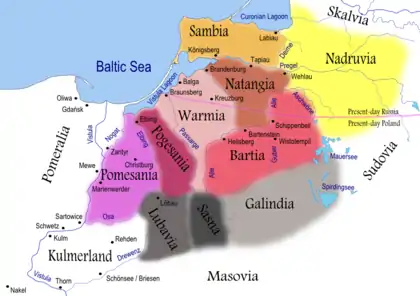
Königsberg was preceded by a Sambian (Old Prussian tribe) fort called Twangste (also spelt Tuwangste or Tvankste), meaning Dam.[21] During the conquest of the Sambians by the Teutonic Knights in 1255, Twangste was destroyed and replaced by a new fortress named Königsberg in the honor of Bohemian king Ottokar II. The declining Old Prussian culture finally became extinct around the 17th century, after the surviving Old Prussians were integrated through assimilation.
Königsberg
The settlement on the site of present-day Kaliningrad was founded as a military fortress in 1255 after the Prussian Crusade by the Teutonic Knights against Baltic Prussians. The new settlement was named in honor of the Bohemian (Czech) King Ottokar II. The crusade was followed by immigrant settlers from Germany and other regions of Western Europe. The city and surrounding area became predominantly German, with Polish, Lithuanian and Latvian minorities.
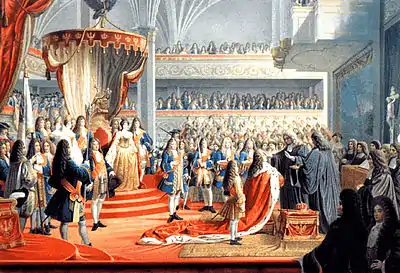
In 1454, the city found itself within the borders of Poland for a year thanks to King Kazimierz Jagiellończyk. After the secularization of the Teutonic Order in 1525, Königsberg became the capital of the Duchy of Prussia, a fiefdom of the Polish king (from 1466). As a symbol of its dependence, the black Prussian eagle had a crown thrust around its neck bearing the letter "S" from the Latinised name of the king, "Sigismundus." In 1618 the Duchy of Prussia passed under the control of the Electors of Brandenburg and in 1657 it became a sovereign state independent of the Polish king, controlled in personal union with Brandenburg (usually referred to as Brandenberg-Prussia). From 1701, Brandenberg-Prussia became a Kingdom and the entire area was referred to as the Kingdom of Prussia. While the Brandenberg portion was a part of the Holy Roman Empire and later the German Confederation, Prussia (later called East Prussia) was not included within those territorial boundaries.
In the ensuing two centuries the city, first as part of the Kingdom of Prussia, then from 1866 as part of the North German Confederation, and then from 1871 as part of the German Empire, continued to flourish and many iconic landmarks of Königsberg were built. The city had around 370,000 inhabitants and was a cultural and administrative center of Prussia and the German Empire. Immanuel Kant and E. T. A. Hoffmann, the notable sons of the city, were born during this time.
World War II
In World War II the city of Königsberg was heavily damaged by a British bombing attack in 1944 and the massive Soviet siege in spring 1945. At the end of World War II in 1945, the city became part of the Soviet Union (as part of the Russian SFSR).
Soviet Union
At the Potsdam Conference in 1945 the Allies agreed on the Soviet annexation pending the final determination of territorial questions at the peace settlement:
The Conference has agreed in principle to the proposal of the Soviet Government concerning the ultimate transfer to the Soviet Union of the City of Koenigsberg and the area adjacent to it as described above subject to expert examination of the actual frontier.[22]
The U.S. President Harry Truman and the British Prime Minister Clement Attlee declared that they would support the proposal of the Conference at the forthcoming peace settlement.[23]
On July 4, 1946 the Soviet authorities renamed Königsberg to Kaliningrad[24] following the death on June 3, 1946 of the Chairman of the Presidium of the Supreme Soviet (titular head of state) of the USSR, Mikhail Kalinin, one of the original Bolsheviks. The surviving German population was forcibly expelled in 1946–1949, and the city was repopulated with Soviet citizens. The city's language of administration was changed from German to Russian.
The city was rebuilt, and as the westernmost territory of the USSR, the Kaliningrad Oblast became a strategically important area during the Cold War. The Soviet Baltic Fleet was headquartered in the city in the 1950s. Because of its strategic importance, Kaliningrad Oblast was closed to foreign visitors.
In 1957 an agreement was signed and later came into force which delimited the border between Poland and the Soviet Union.[25][26]
Russia
The town of Baltiysk, just outside Kaliningrad, is the only Russian Baltic Sea port said to be "ice-free" all year round, and the region hence plays an important role in maintenance of the Baltic Fleet.
Due to the collapse of the Soviet Union in 1991, the Kaliningrad Oblast became an exclave, geographically separated from the rest of Russia. This isolation from the rest of Russia became even more pronounced politically when Poland and Lithuania became members of NATO and subsequently the European Union in 2004. All military and civilian land links between the region and the rest of Russia have to pass through members of NATO and the EU. Special travel arrangements for the territory's inhabitants have been made through the Facilitated Transit Document (FTD) and Facilitated Rail Transit Document (FRTD).[27]
While in the 1990s many Soviet-era city names commemorating Communist leaders were changed (e.g. Leningrad reverting to Saint Petersburg), Kaliningrad remains named as it was.
Since the early 1990s, the Kaliningrad oblast has been a Free Economic Zone (FEZ Yantar). In 2005 the city marked 750 years of existence as Königsberg/Kaliningrad.[28] In July 2007, Russian First Deputy Prime Minister Sergei Ivanov declared that if US-controlled missile defence systems were deployed in Poland, then nuclear weapons might be deployed in Kaliningrad. On November 5, 2008, Russian leader Dmitry Medvedev said that installing missiles in Kaliningrad was almost a certainty.[29] These plans were suspended, however, in January 2009.[30]
But during late 2011, a long range Voronezh radar was commissioned to monitor missile launches within about 6,000 kilometres (3,728 miles). It is situated in the settlement of Pionersky (formerly German Neukuhren) in Kaliningrad Oblast.[31]
In 2018, Kaliningrad hosted some games of the World Cup.
Geography
Kaliningrad is at the mouth of the navigable Pregolya River, which empties into the Vistula Lagoon, an inlet of the Baltic Sea.
Sea vessels can access Gdańsk Bay/Bay of Danzig and the Baltic Sea by way of the Vistula Lagoon and the Strait of Baltiysk.
Until around 1900, ships drawing more than 2 meters (6 ft 7 in) of water could not pass the bar and come into town; larger vessels had to anchor at Pillau (now Baltiysk), where cargo was transferred to smaller vessels. In 1901, a ship canal between Königsberg and Pillau, completed at a cost of 13 million German marks, enabled vessels of a 6.5 meters (21 ft) draught to moor alongside the town (see also Ports of the Baltic Sea).
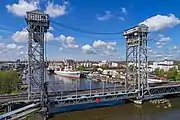 The Pregolya River in Kaliningrad
The Pregolya River in Kaliningrad The pseudo-historic "Fishermen's village"
The pseudo-historic "Fishermen's village".JPG.webp) 13th century Juditten Church
13th century Juditten Church
Climate
Kaliningrad has a humid continental climate (Dfb or Cfb, depending on the isotherm chosen for class C climates), with cold, cloudy, (though moderate compared to most of Russia) winters and mild summers with frequent showers and thunderstorms. Average temperatures range from −1.5 to +18.1 °C (29.3 to 64.6 °F) and rainfall varies from 36.0 millimeters (1.42 in)/month to 97.0 millimeters (3.82 in)/month. In general, it has maritime climate influences and therefore damp, variable and mild, with vast temperature differences between July and January.
The seasons are clearly differentiated. Spring starts in March and is initially cold and windy, later becoming pleasantly warm and often very sunny. Summer, which begins in June, is predominantly warm but hot at times (with temperature reaching as high as +30–+35 °C (86–95 °F) at least once per year) with plenty of sunshine interspersed with heavy rain. The average annual hours of sunshine for Kaliningrad are 1700, similar to other northern cities. Autumn comes in September and is at first warm and usually sunny, turning cold, damp and foggy in November. Winter includes periods of snow. January and February are the coldest months with the temperature sometimes dropping as low as −15 °C (5 °F).
| Climate data for Kaliningrad | |||||||||||||
|---|---|---|---|---|---|---|---|---|---|---|---|---|---|
| Month | Jan | Feb | Mar | Apr | May | Jun | Jul | Aug | Sep | Oct | Nov | Dec | Year |
| Record high °C (°F) | 12.7 (54.9) |
15.6 (60.1) |
23.0 (73.4) |
28.5 (83.3) |
30.6 (87.1) |
34.0 (93.2) |
36.3 (97.3) |
36.5 (97.7) |
33.8 (92.8) |
26.4 (79.5) |
19.4 (66.9) |
13.3 (55.9) |
36.5 (97.7) |
| Average high °C (°F) | 0.7 (33.3) |
1.5 (34.7) |
5.6 (42.1) |
12.3 (54.1) |
18.0 (64.4) |
20.5 (68.9) |
23.0 (73.4) |
22.6 (72.7) |
17.6 (63.7) |
12.1 (53.8) |
5.6 (42.1) |
1.9 (35.4) |
11.8 (53.2) |
| Daily mean °C (°F) | −1.5 (29.3) |
−1.1 (30.0) |
2.0 (35.6) |
7.3 (45.1) |
12.5 (54.5) |
15.5 (59.9) |
18.1 (64.6) |
17.6 (63.7) |
13.1 (55.6) |
8.4 (47.1) |
3.3 (37.9) |
−0.3 (31.5) |
7.9 (46.2) |
| Average low °C (°F) | −3.9 (25.0) |
−3.6 (25.5) |
−1.1 (30.0) |
2.9 (37.2) |
7.4 (45.3) |
10.9 (51.6) |
13.6 (56.5) |
13.1 (55.6) |
9.2 (48.6) |
5.2 (41.4) |
1.1 (34.0) |
−2.5 (27.5) |
4.4 (39.9) |
| Record low °C (°F) | −32.5 (−26.5) |
−33.3 (−27.9) |
−21.7 (−7.1) |
−5.8 (21.6) |
−3.1 (26.4) |
0.7 (33.3) |
4.5 (40.1) |
1.6 (34.9) |
−2.0 (28.4) |
−11.2 (11.8) |
−18.7 (−1.7) |
−25.6 (−14.1) |
−33.3 (−27.9) |
| Average precipitation mm (inches) | 68 (2.7) |
49 (1.9) |
52 (2.0) |
36 (1.4) |
54 (2.1) |
79 (3.1) |
77 (3.0) |
97 (3.8) |
74 (2.9) |
82 (3.2) |
83 (3.3) |
73 (2.9) |
824 (32.4) |
| Average rainy days | 14 | 13 | 14 | 14 | 14 | 16 | 15 | 16 | 17 | 18 | 18 | 16 | 185 |
| Average snowy days | 15 | 15 | 10 | 3 | 0.1 | 0 | 0 | 0 | 0 | 1 | 7 | 13 | 64 |
| Average relative humidity (%) | 85 | 83 | 78 | 72 | 71 | 74 | 75 | 77 | 81 | 83 | 86 | 87 | 79 |
| Mean monthly sunshine hours | 35 | 61 | 120 | 171 | 253 | 264 | 257 | 228 | 158 | 96 | 38 | 26 | 1,707 |
| Source 1: Pogoda.ru.net[32] | |||||||||||||
| Source 2: NOAA (sun 1961–1990)[33] | |||||||||||||
Demographics
The original German population fled or was expelled at the end of World War II when the territory was annexed by the Soviet Union. In October 1945, only about 5,000 Soviet civilians lived in the territory.[34] Between October 1947 and October 1948, about 100,000 Germans were forcibly moved to Germany.[35] By 1948, about 400,000 Soviet civilians arrived in the Oblast.[34]
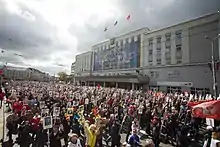

Today the overwhelming majority Kaliningrad's residents are of Russian ethnicity settled after 1945. A minority of the population are from other Slavic people. Kaliningrad today is home to communities of Ukrainian, Belarusian, Tatar, German, Armenian, Polish, and Lithuanian.
Ethnic composition, Russian 2010 census:
| Ethnicity | total population | % of the population |
|---|---|---|
| Russians | 351,186 | 87.4 % |
| Ukrainians | 16,053 | 4.0 % |
| Belarusian | 15,077 | 3.7 % |
| Armenians | 3,062 | 0.8 % |
| Tatars | 2,075 | 0.5 % |
| Lithuanians | 1,789 | 0.4 % |
| Germans | 1,676 | 0.4 % |
| Polish | 1,114 | 0.3 % |
| Other ethnicities | 10,041 | 2.5 % |
| All | 401,649 | 100.0 % |
Cityscape
Architecture
The pre-war city center (Altstadt and Kneiphof) currently consists of parks, broad avenues, a square on the site of the former Königsberg Castle, and two buildings: the House of Soviets ("Dom Sovyetov"), roughly on the site of the former castle, and the restored Königsberg Cathedral on the Kneiphof island (now "Kant island"). Immanuel Kant's grave is situated next to the cathedral. Many German-era buildings in the historic city centre have been preserved and even rebuilt, including the reconstruction of the Königsberg Synagogue. The new city centre is concentrated around Victory Square. The Cathedral of Christ the Savior, consecrated in 2005, is located on that square.
The oldest building in Kaliningrad is the Juditten Church (built before 1288). Also worth seeing are the former Stock Exchange, the surviving churches, and the remaining city gates. In counter-clockwise order these gates are: the Sackheim Gate, King's Gate, Rossgarten Gate, Attack Gate (German: Ausfallstor, or Sally Port), Railway Gate (Eisenbahntor), Brandenburg Gate, and Friedland Gate (Friedländer Tor (Kaliningrad)). Apart from the already mentioned Dohna Tower, which houses the Amber Museum, the Wrangel Tower also remains as a reminder of the former Königsberg city walls. Only the gate of the former Fort Friedrichsburg remains.
Monuments
Notable monuments include the statue of Immanuel Kant in front of the Immanuel Kant State University of Russia. The statue was made by notable sculptor Christian Daniel Rauch and unveiled in 1864. The statue was destroyed in 1945, but was remoulded in 1992 on the initiative of Marion Dönhoff, a native East Prussian who became prominent in the West. Also worth seeing is the Cosmonaut monument, which honours the Kaliningrad cosmonauts Alexei Leonov, Yuri Romanenko and Aleksandr Viktorenko. Other statues and monuments include the statue for Duke Albert, the statue for Friedrich Schiller, the statue for Tsar Peter the Great, Vladimir Vysotsky, the "Mother Russia" monument, and the Monument for the 1200 Guardsmen, remembering the Battle of Königsberg.
Parks
Kaliningrad is a "green" city with many parks and areas with many trees and lawns. Parks range from tiny city squares to massive parks.
The Youth Recreation Park is one of the most popular parks in the city. The park was established in the 1920s-'30s in the English style. It reopened its doors post-war and was popular among citizens in the 1980s-1990s with its boat house and tennis courts, as well as merry-go-rounds.[36] The park had a massive reconstruction in 2004 adding a cafe, carting, and various modern entertainments. It is located in the quiet area of the city, in Leningradsky area, and is connected to the Lower Pond. Youth Recreation Park provides entertainment for all age groups. There is also Interpersonal Communications Development Central located in the park.
The Kaliningrad Zoo was opened as the Königsberg Zoo in 1896. The collection, which extends over 16.5 ha, comprises 315 species with a total of 2,264 individual animals (as of 2005). The Kaliningrad Zoo is also an arboretum.
Ponds
Centrally located in the city is Lower Pond, an artificial lake. Lower Pond is surrounded by a promenade and is an area for recreation especially in summer. North of the Lower Pond is the larger Upper Pond in northern Kaliningrad.
Bridges
Leonhard Euler's 1736 paper on the puzzle of the Seven Bridges of Königsberg was a seminal work in the fields of graph theory and topology. Only two of the structures from his era survive.
Kaliningrad Arena
In 2018, a new stadium, Kaliningrad Arena, was built on the Oktyabrsky Island, near the embankment of the Staraya Pregolya River. The stadium has a seating capacity of 35,000.
Culture
Museums in Kaliningrad

There are many museums and a large number of their branches in Kaliningrad.
- Museum of the World Ocean
- Kaliningrad Regional History and Art Museum
- Kaliningrad Regional Amber Museum
- Kaliningrad State Art Gallery
- Friedland Gate Museum
The Kaliningrad Regional Museum of History and Arts is the oldest museum in Kaliningrad, founded in 1946. In addition to the main building, the museum has four branches in Kaliningrad (including "Blindage" and "Fort No. 5") and two in the region.
In 1979, the Kaliningrad Regional Amber Museum was opened in the building of the former defense tower "Don". Initially, it was a branch of the Historical and Art Museum, since 2004 it has been an independent museum.
The Kaliningrad State Art Gallery, which opened on November 24, 1988 , is one of the youngest and fastest growing museums in Russia, known both in our country and abroad. Up to 40 exhibitions of domestic and foreign art are held annually in eight exhibition halls with a total exposition area of more than 3 thousand square meters.
At the beginning of the 21st century, Museum of the World Ocean, which was unique for Russia at the time, was gradually created, which has interesting exhibitions and six museum vessels:
- Research ship-museum "Vityaz"
- Submarine B-413
- Space communication vessel "Cosmonaut Viktor Patsaev"
- Fishing boat-museum "SRT-129"
- Floating lighthouse "Irbensky"
- Icebreaker "Krassin" - moored in St. Petersburg.

The branches of the museum are the King's Gate and the preserved gate of Fort Friedrichsburg.
A museum of ancient found objects has been created. It is located at the Friedland Gate, which itself is a monument of antiquity.
In 2009, the Museum of E. T. A. Hoffmann, a famous writer born in this city, was created. The museum is located in the building of the former cinema "Leningrad", now this building houses the regional music school named after Hoffman.
On June 5, 2016, on the first floor of the Mega-Market shopping center, the Einstein Museum of Entertaining Sciences was opened, the exposition of which consists of interactive exhibits that clearly illustrate various fields of science and demonstrate the manifestation of their laws.[37]
Kaliningrad's museums were visited by roughly 920 thousand people in 2013.[38] And in terms of museum attendance, Kaliningrad region ranks seventh among the regions of Russia.[39]
Theaters and concert halls
There are several theaters in the city:
- Kaliningrad Regional Drama Theater
- Kaliningrad Regional Musical Theater
- Kaliningrad Regional Puppet Theater
- The organ hall of the Kaliningrad Regional Philharmonic is located in the historic building of the former Catholic Church of the Holy Family.
- A large concert hall with two organs located in the Königsberg Cathedral.
- The Variety Theater, located in the House of Arts.
The musical life of the city is rich and diverse. Annual music festivals of various styles and trends are held throughout the year. Under the patronage of the Kaliningrad Regional Philharmonic Society, international festivals and competitions of classical, jazz, organ music (dedicated to Johann Sebastian Bach and Mikael Tariverdiev) are held. Since 2006, the Don Cento Jazz International Jazz Festival has been held in the summer. The city also hosts two major rock festivals: the Night Wolves bike show (July) and Kaliningrad In Rock (August). The Baltic Seasons art festival is held annually.
In 2013, Kaliningrad's theaters were visited by almost 345 thousand people.[38]
Libraries

- Kaliningrad Regional Scientific Library
- Central City Library. A.P. Chekhov
- Kaliningrad Regional Youth Library. V. Mayakovsky
- Kaliningrad Regional Children's Library. A.P. Gaidar
- Kaliningrad Regional Specialized Library for the Blind
Also, there are 20 municipal city libraries in the city. As of 2015, more than 100 thousand residents of Kaliningrad regularly visit the city's libraries.[40]
Music
The modern city of Kaliningrad is home to the Kaliningrad Regional Philharmonic and Symphony Orchestra, the Lik male chamber choir and the Garmonika Russian music ensemble,[41] as well as the Kaliningrad Chamber Orchestra.[42]
Cuisine

Kaliningrad has its own vodka and beer brands, Stari Königsberg and Ostmark respectively. Since the early 1990s many new restaurants have opened in the city. These restaurants offer culinary specialities of former East Prussia, like Königsberger Klopse, and also fish and salad dishes, pizza and sushi. Königsberger Fleck, a bovine tripe soup and yet another culinary specialty from former Königsberg, no longer belongs to the culinary culture of Kaliningrad.
The people of Kaliningrad generally imported their respective culinary traditions to the region when they settled in the area after 1945. Borscht and okroshka may be served as in the rest of Russia. Many Italian and Asian restaurants (or fusions of both traditions) are in operation all over the city. Pizza and sushi are among the most popular dishes today. Fast food is widely available from various chains, including those of foreign origin. Shawarma is also gaining considerable prominence.
Sports

The Russian football club FC Baltika Kaliningrad is based in Kaliningrad and plays in the Russian Football National League. The home stadium is the Kaliningrad Stadium, built for the 2018 FIFA World Cup.
During 2006 to 2013, the Dynamo-Yantar men's volleyball club played in the Russian men's volleyball Championship. They played their home games at the Yantarny Sports Palace, which can accommodate over 7000 spectators. From 2010, Yantarny had regularly hosted matches of the Russian men's national volleyball team in the FIVB Volleyball World League and the FIVB Volleyball World Grand Prix.
In the past, the city was also represented by the football clubs of West, Baltika-2 and FC Baltika-Tarko Kaliningrad, as well as the rugby club West Zvezda (winner of the 1994 Russian Cup, prize winner of the 1994 and 1995 Russian championships). The football club Volna Kaliningrad took part in the third tier of the 2000 Lithuanian championship, LF II Lyga, and won in the western zone (22 games: 20 wins, 2 draws, goal difference 101-9).[43][44]
Since November 2013, the city has had an American football team called Amber Hawks. In 2015, the Amber Hawks reached the semifinals of the Polish League 8x8.[45] In 2016, Amber Hawks took the silver medal of the prestigious Eastern League of American Football (VLAF).[46]
In June 2014, the Kaliningrad Regional Hockey League (KRHL) was created. League competition is the official championship of the Kaliningrad region of hockey.
On April 9, 2018, when in Kaliningrad at a press conference, with the participation of the governor Anton Alikhanov, the Vice Minister of Sports of Kaliningrad Oblast Natalia Ishchenko, the President of the All-Russian Volleyball Federation Stanislav Shevchenko, and the manager of VC Lokomotiv Novosibirsk Roman Stanislavov announced the creation of a women's volleyball team, the "Lokomotiv Kaliningrad Region". At the end of the 2018–2019 season, the club took the second place in the Russian Championship, losing one point to the leader team, the WVC Dynamo Moscow.
Administrative and municipal status
Kaliningrad is the administrative centre of the oblast.[8] Within the framework of administrative divisions, it is incorporated as the city of oblast significance of Kaliningrad—an administrative unit with the status equal to that of the districts.[1] As a municipal division, the city of oblast significance of Kaliningrad is incorporated as Kaliningrad Urban Okrug.[9]
City districts
As of 2014, the city was divided into three administrative districts:
| City district |
Russian name | Inhabitants 2010 Census[6] |
Notes |
|---|---|---|---|
| Moskovsky | Московский | 152,165 | Named after the Russian capital, Moscow |
| Leningradsky | Ленинградский | 159,771 | Named after Leningrad, now Saint Petersburg |
| Tsentralny | Центральный | 119,966 | Lit. central, as it lies to the northwest of the historical city center |
Two administrative districts were abolished in June 2009:
| City district |
Russian name | Inhabitants 2002 Census[47] |
Notes |
|---|---|---|---|
| Baltiysky | Балтийский | 68,664 | Named after the Baltic Sea |
| Oktyabrsky | Октябрьский | 43,252 | Named after the October Revolution |
Authorities
Local government
.jpg.webp)
Local self-government in the city is carried out on the basis of the Charter, which was adopted by the City Council of Deputies of Kaliningrad on July 12, 2007.
Bodies and officials of local self-government in the city (formally - in the city district) Kaliningrad are:
- Council of Deputies ( representative body of a municipal formation )
- Head (chief executive)
- Administration (executive and administrative body of the municipality)
- Chamber of Control and Accounts
The City Council of Deputies consists of 28 deputies elected by city residents in municipal elections according to a mixed mandate distribution system for a period of 5 years. The chairman of the Council is elected by deputies from among its members. The current 6th convocation was elected on September 18, 2016 . The Chairman of the Council is Andrey Kropotkin from United Russia.
The head of the city heads the administration of the city district. Elected by the City Council of Deputies from among the candidates presented by the Competition Commission based on the results of the competition, for the term of office of the City Council of Deputies. Since April 2018, the head of the city is Alexey Silanov.[48]
The Kaliningrad administration and the Council of Deputies are located in the building of the mayor's office at the Victory Square.[49]
From 1996 to 2007, the Charter of the City of Kaliningrad dated September 25, 1996 was in force in Kaliningrad , according to which the local self-government bodies were:
- The head of the city (mayor) - the highest official of the city;
- City hall (executive and administrative body);
- City Council of Deputies (representative body).
In 2007, due to the reform of local self-government, the functions of local self-government bodies were changed, and a new position was introduced - the head of the administration.
In 2008-2012, the local government body, carrying out executive and administrative functions, was the city district administration, headed by the head of the administration (city manager). The head of the administration was appointed to the post by the decision of the District Council of Deputies following a competition. On May 14, 2008, Felix Lapin was appointed to this position for a period of 2 years. On June 15, 2011, deputies of the Kaliningrad District Council approved Svetlana Mukhomor as head of the city administration (currently she is the first deputy head of the city administration).[50]
In November 2016, the Kaliningrad Regional Duma adopted a law abolishing direct elections for the mayor of Kaliningrad.[51] The elections were replaced by the selection procedure of candidates by a competition commission from which the city Council of Deputies selects one by secret ballot. In 2018, out of ten people who submitted documents for participation in the competition, only three were admitted to the competition.[52]
Regional government
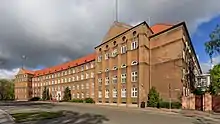
All legislative, executive and judicial authorities of Kaliningrad Oblast are located in Kaliningrad. The Government of Kaliningrad Oblast and the Governor's Administration are located in the same building on Dmitry Donskoy Street, the Kaliningrad Regional Duma - on Kirov Street, the Kaliningrad Regional Court - on Sergeeva Street, the Arbitration Court of Kaliningrad Oblast - on Rokossovsky Street.
Federal government
In Kaliningrad, there are representative offices of federal authorities in the region:
- Prosecutor's Office of Kaliningrad Oblast
- Investigation Department of the Investigative Committee of Russia
- Ministry of Internal Affairs of Kaliningrad Oblast
- Ministry of Emergency Situations
- Military Commissariat
- Kaliningrad Regional Customs of the North-West Customs Department of the Federal Customs Service of Russia
- Branch of the Pension Fund of the Russian Federation
- Management of the federal postal service - branch of FSUE "Russian Post"
- Branch of the Social Insurance Fund of the Russian Federation
Economy
In 1996, Kaliningrad was designated a Special Economic Zone, referred to as FEZ Yantar. Manufacturers based there get tax and customs duty breaks on the goods they send to other parts of Russia. Although corruption was an early deterrent, that policy means the region is now a manufacturing hub. One in three televisions in Russia are made in Kaliningrad (including Ericsson brand by Telebalt Ltd. and Polar by an eponymous firm located in the city of Chernyakhovsk) and it is home to Cadillac and BMW related car plants (produced by Avtotor). Currently, Kaliningrad's major industries are manufacturing, shipping, fishing and amber products. In 2006, Moscow declared it would turn the region into "the Russian Hong Kong".[53]
The European Commission provides funds for business projects under its special programme for Kaliningrad. With an average GDP growth of more than 10% per year for three years to 2007, Kaliningrad grew faster than any other region in Russia, even outstripping the success of its EU neighbours. By early 2015, the BBC reported the region's trade with the countries of the EU was increasing, with improved economic growth and industrial output.[54]
Education
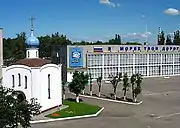
Today, there are 21 higher educational institutions in Kaliningrad (together with branches of universities in other cities), of which state-owned are:
- The Kaliningrad branch of the St. Petersburg University of the Ministry of Internal Affairs of Russia, previously the Kaliningrad Law Institute of the Ministry of Internal Affairs of Russia (KYUI), even earlier - the Kaliningrad Higher School of the Ministry of Internal Affairs of the Russian Federation, which was formed on the basis of the Kaliningrad Special Secondary School of Police of the Ministry of Internal Affairs of the USSR.
- Immanuel Kant Baltic Federal University. Until 2011 - Russian State University. I. Kant. The name of Kant was given on the eve of the city's 750th anniversary in 2005. Previously - Kaliningrad State University (KSU). Occupies the building of the former German University of Königsberg.
- Baltic State Academy of Fishing Fleet (BFFSA). Until 1991 - Kaliningrad Higher Marine Engineering School (KVIMU).
- Kaliningrad State Technical University (KSTU). Previously - Kaliningrad Technical Institute of the Fishing Industry and Economy (KTIRPiH).
- Kaliningrad Border Institute of the Federal Security Service of the Russian Federation. Previously - Kaliningrad Higher Engineering School of Engineering Troops named after A.A.Zhdanov (KVIUIV).
- The FF Ushakov Baltic Naval Institute, now a branch of the military educational and scientific center of the Russian Navy "Naval Academy named after Admiral of the Fleet of the Soviet Union N. G. Kuznetsov." Previously - Kaliningrad Higher Naval School (KVVMU).
Also in Kaliningrad there is a branch of the North-West Academy of Public Administration and National Economy, from secondary educational institutions - three gymnasiums, six lyceums and forty-seven secondary schools. There are educational institutions of secondary vocational education: Kaliningrad Regional College of Music. S. V. Rachmaninova, Kaliningrad State College of Urban Development, Kaliningrad Marine Fisheries College and others; to the IKBFU I. Kant included the Kaliningrad Technical College, the Communal Construction College. In addition, there is one cadet corps - KSH "Andrew the First-Called Cadet Naval Corps" (APKMK).
In August 2019, construction began on a branch of the Nakhimov Naval School. The opening is scheduled for September 1, 2020, the number of students will be over 560 people.[55]
Transport
Roads
Kaliningrad is a major transport hub. The most important roads of the city are:
 Kaliningrad - Chernyakhovsk - Nesterov to the Lithuania-Russia border (on to Vilnius, Minsk, route M1 "Belarus") It is a part of the branches of the trans-European transport corridors No. 1-A "Riga - Kaliningrad - Gdansk" and No. 9-D "Kiev - Minsk - Vilnius - Kaliningrad",
Kaliningrad - Chernyakhovsk - Nesterov to the Lithuania-Russia border (on to Vilnius, Minsk, route M1 "Belarus") It is a part of the branches of the trans-European transport corridors No. 1-A "Riga - Kaliningrad - Gdansk" and No. 9-D "Kiev - Minsk - Vilnius - Kaliningrad",  and
and 
 Kaliningrad - Gvardeisk - Neman to the Lithuania-Russia border (on to Siauliai, Jelgava, Riga). The route from the village - Talpaki, through Bolshakovo to Sovetsk. It is a part of the branch of the trans-European transport corridor No. 1-A "Riga - Kaliningrad - Gdansk".
Kaliningrad - Gvardeisk - Neman to the Lithuania-Russia border (on to Siauliai, Jelgava, Riga). The route from the village - Talpaki, through Bolshakovo to Sovetsk. It is a part of the branch of the trans-European transport corridor No. 1-A "Riga - Kaliningrad - Gdansk". 
- Kaliningrad - Mamonovo. Through Ladushkin to the Poland-Russia border (to Elbląg, Gdańsk).
 and
and 
- Kaliningrad - Polessk. It follows through the village. Bolshakovo (further to Sovetsk)
- Kaliningrad - Zelenogradsk. (further along the Curonian Spit to Nida and Klaipeda)
- Kaliningrad - Baltiysk. The road runs through Primorsk.
- Kaliningrad - Bagrationovsk. Leads to the Polish border (further to Olsztyn).
In December 2007, construction began on the Primorskoye Koltso highway, which currently connects Kaliningrad with Svetlogorsk, Pionersky, Zelenogradsk and Khrabrovo Airport. It is planned to continue construction at Baltiysk, Svetly.
Around the city (from the village of A. Kosmodemyansky to the traffic intersection with Moskovsky Prospekt) passes the route of the Northern Bypass of Kaliningrad and the Southern Bypass of Kaliningrad (from the traffic junction with Moskovsky Prospekt inclusive to the village of Shosseinoe (the Kaliningrad-Mamonovo highway), called Bolshoi By the ring road Until now, on the western side of the city of Kaliningrad, the "ring" of the road has not been closed due to the absence of a 7-kilometer crossing through the Vistula Lagoon.
Water
Kaliningrad is home to the westernmost and the only non-freezing port of Russia and the Baltic states on the Baltic Sea. Freight and passenger ferry crossings connect the Port of Kaliningrad, and its outport, the Port of Baltiysk with Saint Petersburg, and the ports of Germany and Sweden.
As of April 2019, only a freight ferry operates on the Baltiysk - Ust-Luga route, and the passenger ferry has been cancelled.[56][57]
Air
The Kaliningrad Devau Airport, which opened in 1919, was one of the first civilian airports in the world, and the first in Germany. In 1922, the first planes of the Moscow-Riga-Königsberg, the first international airline of the Soviet Union, arrived in here for the first time. After World War II, the airport was used for local flights until the 1970s.
In the fifties, a new airport, the Khrabrovo Airport, was built on the base of a military airfield 24 kilometres from the city. Now it has international status. The Kaliningrad airline KD Aviation was based on Khrabrovo, which ceased operations in September 2009. The reconstruction of the airport has been completed in 2018.
Railway
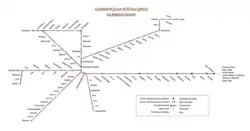
Kaliningrad is the most important hub of the railway network of the Kaliningrad Oblast. It is the site of the Kaliningrad Railway.
The main passenger railway station of the city is the Kaliningrad South railway station, which includes the main railway station of the city and the Oblast - Yuzhny station, it serves both commuter and long-distance trains following from Kaliningrad:
- No. 30 Moscow "Yantar"
- No. 80 St. Petersburg
- No. 148 Moscow (summer)
- No. 360 Adler
- No. 426 Chelyabinsk (summer)
The Berlin-Kaliningrad direct train (via Poland) operated from 1993 to 2000, then was replaced by a non-stop carriage, which was part of the Kaliningrad-Gdynia train from December 2003 to December 2009 and in 2010-2013 (in the summer), with a re-trailer in the Polish city of Tczew. A platform with a "European" track was specially equipped to receive these trains, allowing trains to run on this message without rearranging the wheel pairs.
Kaliningrad North railway station serves trains connecting Kaliningrad with the seaside resorts of the city, Svetlogorsk and Pionersky, as well as the city of Sovetsk. It is a major transport hub in the public transport system of Kaliningrad.
Other railway stations located in the city:
- Kutuzovo-Novoy (Alexander Nevsky Street District)
- Chkalovsk-Western (Mck. Chkalovsk)
- West New (Wagon Street District)
- Forest-Novoya (Mcn. named after Alexander Kosmodemyansky)
- Dzerzhinskaya-Novaya (Dzerzhinsky Street district, there is a European narrow track)
- Aivazovsky stop (in the area of Aivazovsky and Yamskaya streets)
- Kiev stop (Kievskaya Street district, near the Baltic market)
- Selma stop (General Chelnokov Street and Selma Market)
- Stop point 4 kilometer (Muromskaya Street District, Southern)
- Brusnichny Stop (Brusny street district)
Inter-city and International bus service
Regular bus routes connect Kaliningrad with Belarus, Ukraine, Lithuania, Latvia, Estonia, Poland, the Czech Republic and Germany.
There are two bus stations in the city. The “old” bus station is located on Kalinin Square, next to the Kaliningrad-Passazhirskiy railway station and is used primarily for intra-regional transportation.
Due to the conflict with the station directorate, the Königavto road carrier stopped using this bus station and set up its own international bus station at the end of Moskovsky Prospekt. More than 90% of regular international bus services depart from it.
Urban public transport
Public transport in Kaliningrad is represented by a bus, a trolleybus, a tram, a taxi, and the city's railway lines. On March 21, 2010, a new public transport scheme came into effect.[58]
The tram network in Kaliningrad has been in existence since 1895 and is the oldest tram system in Russia. It has a track width of 1000 mm. Until 2000, at least ten city tram routes operated in Kaliningrad, however, over the past twenty years, the route network has been significantly reduced.[59] By the beginning of 2013, only two routes were operating in the city. In 2015, after changing the traffic pattern at the Kaliningrad South railway station, the last tram route No. 5 remained. In accordance with the newly adopted General Plan of Kaliningrad until 2035, the construction of a tram line with a separate traffic section in the Moskovsky District is envisaged.
The first trolleybuses appeared in Königsberg in 1943, but after the war they decided not to restore the trolleybus movement. The modern trolleybus system of the city has been operating since November 5, 1975.[60] During this time, the route network in Kaliningrad has repeatedly changed. After the repair of the overpass on Pobedy Avenue, carried out in the summer of 2018, route No. 6 was abolished running from the street. As a result, three operating trolleybus lines remained in the city, although the new route scheme for public transport, adopted on August 1, 2016, provided for six routes.[61] The general plan of the city until 2035 also provides for the development of the trolleybus network in Kaliningrad.
Railbus
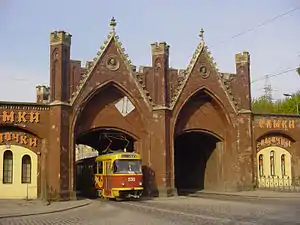
On March 26, 2014, the first line of the city rail bus was launched in Kaliningrad , serving the route from the Kievskaya platform in the Moskovsky district to the Kaliningrad North railway station. At the same time, a bus line was organized connecting Oleg Koshevoy Street with the Kievskaya platform. The opening of several more lines of the city railway has been announced , which should connect the center of Kaliningrad with the peripheral districts of the city.[62][63]
In December 2016, the mayor of Kaliningrad, Alexander Yaroshuk, announced that from January 1, 2017, the city rail bus would be canceled due to its unprofitability.[64] After that, Governor Anton Alikhanov made an operational decision to subsidize the rail bus from the regional budget.[65]
In early January 2017, the press service of the Kaliningrad Railway announced that it was planned to extend the rail bus line to Chkalovsk.[66]
On January 9, 2017, city trains were launched on the Kaliningrad-Guryevsk route, and from September 3, 2018 on the Kaliningrad-Lesnoye Novoe route.
As of the end of 2018, rail buses serve four intra-city lines connecting peripheral sleeping areas and the satellite city of Guryevsk with the center of Kaliningrad. Kaliningrad North railway station is a major transport and interchange hub, where many public transport routes converge. Passengers are transported by rail buses of the RA1 and RA2 models, manufactured by Metrovagonmash. City trains run on weekdays during the morning and evening rush hours.
Bridges

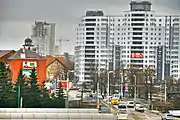
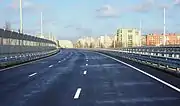
The branches of the Pregolya River divide the city into four parts. Majority of the city (Tsentralny Administrative District and Leningradsky Administrive District) is located north of the river, Moskovsky Administrative District is south of the river. Kant Island (Kneiphof) and Oktyabrsky Administrative District (Lomse) are located between the branches of the river.
There are eight active bridges across the Pregolya and one dismantled in Kaliningrad.
- The Two-tiered bridge is a drawbridge that connects General Butkov (northern bank) and Zheleznodorozhnaya (southern bank) streets. Divorced by raising the middle span. The upper tier of the bridge is occupied by a railway, the lower - by the carriageway and pedestrian sidewalks. The double-deck bridge is the only existing railway bridge across the Pregolya in Kaliningrad.
- Trestle bridge - thrown over both branches of the Pregolya and passes over Kneiphof, is part of the Leninsky Prospekt, built in 1972,[67] to replace two of the seven Königsberg bridges - Lavochny and Zeleny. There is a pedestrian descent from the bridge to the island, an automobile exit to Moskovsky Prospekt . There is no road exit to the island. The bridge is crossed by routes of all types of public transport.
- The Wooden Bridge is a drawbridge, one of the seven bridges in Königsberg. Connects Moskovsky Prospekt with Oktyabrsky Island (Oktyabrskaya st.). There are two tram routes across the bridge
- The Honey Bridge is a drawbridge, one of the seven bridges of Königsberg. Connects Oktyabrsky Island and Kneiphof. Since the Kneiphof is a pedestrian zone, the de facto bridge is also exclusively pedestrian. From time to time, the bridge is used by official vehicles (delivery of materials for the restoration of the Königsberg Cathedral, as well as for the passage of wedding corteges).
- Jubilee Bridge - drawbridge, pedestrian, connects Oktyabrsky Island (Rybnaya village area) with St. Epronovskaya. Built in 2005 on the pillars of the old Imperial Bridge, destroyed during World War II.
- The High Bridge is one of the seven bridges in Königsberg. Connects st. Oktyabrskaya (Oktyabrsky Island) from st. Dzerzhinsky. A tram line runs across the bridge.
- Berlin (Palmburg) Bridge is part of the Kaliningrad ring road, it is thrown across both channels of the Pregolya. Farthest from the city center. After the war, it was only partially restored (one strip). Currently, a three-lane bridge was built in its place, reconstructed in 2014.
- The old railway bridge is a drawbridge, located in the area of the Museum of the World Ocean. Divorced by raising the middle span. The middle span is dismantled, the bridge is not used in any way. An abandoned railway line crosses the bridge.
- The Second Overpass Bridge was commissioned in December 2011. The bridge crosses both channels of the Pregolya and passes over Oktyabrsky Island, connecting April 9 Street in the right-bank part of the city with Dzerzhinsky Street in the left-bank part. The total length is 1883 m. The bridge has three lanes in each direction. The design speed of vehicles is not less than 80 km/h.
Seven bridges existed in Königsberg in the 16th-20th centuries. The relative position of the bridges led to the mathematical problem of Seven Bridges of Königsberg, and prompted the mathematician Leonard Euler to speculate, which led to the emergence of graph theory.
Media
Television
The Kaliningrad television studio has existed since 1958 with its own frequency channel and daily 6-7-hour broadcasting, then it was called the Yantar TV and Radio Company. Currently, it has lost its channel and most of its airtime, it is a branch of the All-Russia State Television and Radio Broadcasting Company
Kaliningrad television networks:
Radio
Kaliningrad radio stations:
|
|
Notable people
- Immanuel Kant (1724–1804) , philosopher
- E. T. A. Hoffman (1776-1882) author, playwright, composer
- Sergey Snegov (1910–1994), science fiction writer
- Viktor Patsayev (1933–1971)
- Alexei Leonov (1934–2019), first person to walk in space
- Yury Romanenko (born 1944)
- Alexander Viktorenko (born 1947)
- Oleg Gazmanov (born 1951), singer
- Sergei Beloglazov (born 1956), Olympic wrestler
- Lyudmila Putina (born 1958), ex-wife of Vladimir Putin, First Lady of Russia
- Alexander Volkov (born 1967), tennis player
- Dmitry Lapikov (born 1982), Olympic weightlifter
- Tvangeste, symphonic black metal band
- Maksim Zuyev, journalist and activist
- Anastasia Nazarenko (born 1993), rhythmic gymnast
- Costa Ronin (born 1979),Russian-born New Zealand actor
International relations
Diplomatic missions
In 2004, Germany opened a consulate general in Kaliningrad.[68] This consulate allows Kaliningrad residents to get Schengen visas without having to travel to Moscow. An agreement between Gerhard Schröder, Chancellor of Germany, and President of Russia Vladimir Putin established the consulate in light of Lithuania and Poland, which surround Kaliningrad, joining the EU. Russian concerns with Germany wanting the former Königsberg back had stifled earlier plans for a German consulate.[69][70][71]
Small border traffic law
Poland and the Russian Federation have an agreement whereby residents of Kaliningrad and the Polish cities of Olsztyn, Elbląg and Gdańsk may obtain special cards permitting repeated travel between the two countries, crossing the Polish–Russian border. As of July 2013, Poland had issued 100,000 of the cards. That year, Russians visiting Poland to shop at the Biedronka and Lidl supermarkets featured in songs by musical group Parovoz.[72]
Twin towns – sister cities
Kaliningrad is twinned with:[73]
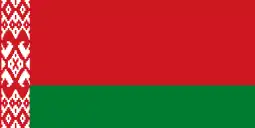 Baranavichy, Belarus
Baranavichy, Belarus Białystok, Poland
Białystok, Poland Bremerhaven, Germany
Bremerhaven, Germany Brest, Belarus
Brest, Belarus Cagliari, Italy
Cagliari, Italy Catania, Italy
Catania, Italy Elbląg, Poland
Elbląg, Poland Forlì, Italy
Forlì, Italy Gdańsk, Poland
Gdańsk, Poland Gdynia, Poland
Gdynia, Poland Gomel, Belarus
Gomel, Belarus Groningen, Netherlands
Groningen, Netherlands Kalmar, Sweden
Kalmar, Sweden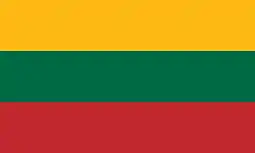 Kaunas, Lithuania
Kaunas, Lithuania Kętrzyn County, Poland
Kętrzyn County, Poland Kiel, Germany
Kiel, Germany Klaipėda, Lithuania
Klaipėda, Lithuania Łódź, Poland
Łódź, Poland Norfolk, United States
Norfolk, United States Olsztyn, Poland
Olsztyn, Poland Panevėžys, Lithuania
Panevėžys, Lithuania Racibórz, Poland
Racibórz, Poland Šiauliai, Lithuania
Šiauliai, Lithuania Toruń, Poland
Toruń, Poland Zabrze, Poland
Zabrze, Poland Zeitz, Germany
Zeitz, Germany
See also
References
Notes
- Resolution #640
- Article 6 of the Charter of Kaliningrad states that the city may have an anthem, providing one is officially adopted. As of 2015, an anthem is not listed among the symbols of the city shown on the official website of Kaliningrad.
- Official website of Kaliningrad. Passport of Kaliningrad Urban Okrug. (in Russian)
- Charter of Kaliningrad, Article 25
- Official website of Kaliningrad. Head of the City, Alexander Georgiyevich Yaroshuk. (in Russian)
- Russian Federal State Statistics Service (2011). "Всероссийская перепись населения 2010 года. Том 1" [2010 All-Russian Population Census, vol. 1]. Всероссийская перепись населения 2010 года [2010 All-Russia Population Census] (in Russian). Federal State Statistics Service.
- "26. Численность постоянного населения Российской Федерации по муниципальным образованиям на 1 января 2018 года". Federal State Statistics Service. Retrieved January 23, 2019.
- Law #463
- Law #397
- "Об исчислении времени". Официальный интернет-портал правовой информации (in Russian). June 3, 2011. Retrieved January 19, 2019.
- Почта России. Информационно-вычислительный центр ОАСУ РПО. (Russian Post). Поиск объектов почтовой связи (Postal Objects Search) (in Russian)
- В.И. Кулаков, Д.А. Пуляева. "Кaliningrad". Большая российская энциклопедия. Retrieved August 4, 2020.
- "RUSSIA: Severo-Zapadnyj Federal'nyj Okrug: Northwestern Federal District". City Population.de. August 8, 2020. Retrieved August 28, 2020.
- "Система расселения России: тенденции к переменам". Демоскоп Weekly. August 1–19, 2012. Retrieved August 4, 2020.
- "Биполярная модель межрегионального сотрудничества"Трехградье (Польша) — Калининград (Россия)"" [Bipolar model of interregional cooperation "Tricity (Poland) - Kaliningrad (Russia)"] (PDF).
- Alexander Akishin (December 16, 2013). "250 крупнейших промышленных центров России". Urbanica. Retrieved July 30, 2020.
- "100 лучших городов России". Kommersant Secret Firmy. April 2, 2013. Retrieved July 31, 2020.
- "30 лучших городов для бизнеса 2013". Forbes. Retrieved July 31, 2020.
- Кирилл Алексеев (November 5, 2019). "Рейтинг комфортности городов России: Пионерский на первом месте, Калининград - на пятом". Komsomolskaya Pravda. Retrieved August 4, 2020.
- "Калининград включили в список крупнейших центров миграционного притяжения". Klops. June 27, 2014. Retrieved August 4, 2020.
- Prussian dictionary https://wirdeins.twanksta.org/#tw%C4%81nksta
- Protocol of the Proceedings of the Berlin Conference
- "The Potsdam Declaration". ibiblio.org. Retrieved December 29, 2014.
- Decree of July 4, 1946
- "Russia (USSR) / Poland Treaty (with annexed maps) concerning the Demarcation of the Existing Soviet-Polish State Frontier in the Sector Adjoining the Baltic Sea March 5, 1957" (PDF). un.org. Retrieved December 29, 2014.
- For other issues of the frontier delimitation see "Maritime boundary delimitation agreements and other material". un.org. Retrieved December 29, 2014.
- "Facilitated transit document (FTD) and facilitated rail transit document (FRTD)". EUR-lex. January 7, 2020. Retrieved July 5, 2020.
- "Kaliningrad's 750th anniversary". New York Times. July 3, 2005. Retrieved December 29, 2014.
- Gutterman, Steve; Isachenkov, Vladimir (November 6, 2008). "Medvedev Says Russia to Deploy Missiles Near Poland". Associated Press – via Fox News.
- Harding, Luke (January 28, 2009). "Russia scraps plans to deploy nuclear-capable missiles in Kaliningrad". The Guardian. Retrieved December 21, 2013.
- Sudakov, Dmitry (November 28, 2011). "Russia's new radar to monitor all Europe including Britain". Pravda.ru. Retrieved December 21, 2013.
- "Weather and Climate-The Climate of Kaliningrad" (in Russian). Погода и климат. Retrieved April 5, 2016.
- "Kaliningrad Climate Normals 1961–1990". National Oceanic and Atmospheric Administration. Retrieved April 5, 2016.
- Malinkin, Mary Elizabeth (February 8, 2016). "Building a Soviet City: the Transformation of Königsberg". Wilson Center. Archived from the original on July 7, 2017. Retrieved May 2, 2018.
- Berger, Stefan (May 13, 2010). "How to be Russian with a Difference? Kaliningrad and its German Past". Geopolitics. 15 (2): 345–366. doi:10.1080/14650040903486967. S2CID 143378878.
- "Новости! Анонсы! Акции! | Парк "Юность", г.Калининград". www.park-unost.ru. Retrieved August 18, 2017.
- "Музей занимательных наук Эйнштейна". KDGid.ru. June 11, 2016. Archived from the original on August 21, 2020. Retrieved August 21, 2020.
- Екатерина Апанова (May 29, 2015). ""Машины, врачи и преступность": польская служба статистики сравнила Калининград и Гданьск". KGD.ru. Retrieved August 23, 2020.
- "Концепция создания музея перемещённых ценностей на территории Калининградской области" (PDF).
- Денис Костоглодов (March 3, 2015). "Апполонова: Каждый четвёртый житель Калининграда посещает городские библиотеки". KGD.ru. Retrieved August 23, 2020.
- "Russia's Daily Online". Kommersant. Archived from the original on August 31, 2009. Retrieved June 27, 2009.
- "Shostakovich & Schnittke Concertos". Classicstoday.com. Retrieved January 31, 2014.
- "Свой среди чужих. Футбольные клубы, играющие в чемпионате другой страны". iSport.uа. October 18, 2013. Retrieved September 1, 2020.
- "Where's My Country?". rsssf.com. Archived from the original on September 1, 2020.
- Radosław Gołąb (October 15, 2015). "Ósemkowa kulminacja - PLFA". PLFA.pl. Retrieved September 1, 2020.
- Евгений Шуваев (September 11, 2016). "ВЛАФ. "Рыси" обыграли "Янтарных Ястребов" и взяли титул". first & goal.ru. Retrieved September 1, 2020.
- Russian Federal State Statistics Service (May 21, 2004). "Численность населения России, субъектов Российской Федерации в составе федеральных округов, районов, городских поселений, сельских населённых пунктов – районных центров и сельских населённых пунктов с населением 3 тысячи и более человек" [Population of Russia, Its Federal Districts, Federal Subjects, Districts, Urban Localities, Rural Localities—Administrative Centers, and Rural Localities with Population of Over 3,000] (XLS). Всероссийская перепись населения 2002 года [All-Russia Population Census of 2002] (in Russian).
- "Алексей Силанов стал новым мэром Калининграда". RIA Novosti. April 18, 2018. Retrieved September 1, 2020.
- "Раздел личного приёма граждан на официальном сайте Администрации Калининграда". KLGD.ru. Retrieved September 1, 2020.
- "Светлана Мухомор стала главой администрации Калининграда". KLGD.ru. June 15, 2011. Retrieved September 1, 2020.
- "В Калининграде отменили прямые выборы мэра". Kommersant. November 24, 2016. Retrieved September 1, 2020.
- "К конкурсу на должность главы Калининграда были допущены три кандидата". Interfax.ru. April 16, 2018. Retrieved September 1, 2020.
- Sheeter, Laura (October 16, 2006). "'Kaliningrad erases stains of past' 16 October 2006". BBC News. Retrieved December 21, 2013.
- "'Regions and territories: Kaliningrad' 18 December 2007". BBC News. October 5, 2013. Retrieved December 21, 2013.
- "Министр обороны РФ принял участие в церемонии закладки камня под строительство филиала Нахимовского военно-морского училища в Калининграде". Ministry of Defense of the Russian Federation. August 13, 2019. Retrieved August 7, 2020.
- "Паром Калининград – Санкт-Петербург. Паромная линия Балтийск – Усть-Луга - ТБК - Калининград". transbc.ru. Retrieved August 4, 2020.
- "Паром Санкт-Петербург - Калининград. Паромная линия Усть-Луга - Балтийск". Trans-Exim. Retrieved August 4, 2020.
- Константин Киврин (March 15, 2010). "Транспортный тупик: новая маршрутная сеть Калининграда". KGB.ru. Retrieved August 4, 2020.
- "В Калининграде отменяют два маршрута трамвая и троллейбуса". newkaliningrad.ru. January 10, 2010. Retrieved August 4, 2020.
- Юрий Грозмани (December 9, 2004). "Из истории "рогатых": "Советский троллейбус в Кёнигсберге"". data9.gallery.ru. Retrieved August 4, 2020.
- Юлия Лунская (July 14, 2016). "Новая маршрутная сеть в Калининграде начнёт действовать с августа". TR.ru. Retrieved August 4, 2020.
- "В Калининграде открылась первая ветка наземного метро". Klops.ru. March 26, 2014. Retrieved August 4, 2020.
- "С 26 марта в Калининграде начнёт ходить рельсобус с ул. Киевской до Северного вокзала". KGD.ru. March 24, 2014. Retrieved August 4, 2020.
- Денис Костоглодов (December 20, 2016). "Власти Калининграда решили отменить рельсобус с Северного вокзала на улицу Киевскую". KGD.ru. Retrieved August 4, 2020.
- Елена Калугина (December 23, 2016). "Областное правительство решило забрать у Калининграда маршрут рельсобуса". KGD.ru. Retrieved August 4, 2020.
- "Маршрут рельсобуса от улицы Киевской продлят до посёлка Чкаловск". KGD.ru. January 8, 2017. Retrieved August 4, 2020.
- Исторический календарь Калининграда // Журнал «Запад России», № 1 (18) 1997 год, стр 40.
- "Consulate General of Germany in Kaliningrad, Russia." Embassypages.com. Retrieved on Feb 5, 2019.
- "Fischer Establishes German Outpost in Kaliningrad." Deutsche Welle. 12 February 2004. Retrieved on 16 May 2016.
- Kovalev, Vladimir. "No Building for German Consulate." The Moscow Times. August 30, 2004. Retrieved on Feb 5, 2019.
- DW Staff (dsl). "Fischer Establishes German Outpost in Kaliningrad." Deutsche Welle. February 12, 2004. Retrieved on Feb 5, 2019.
- A.C. (October 8, 2013). "Poland and Kaliningrad: Small Border Traffic". Economist blog. Archived from the original on October 8, 2013. Retrieved December 29, 2014.
- "Города-партнеры". klgd.ru (in Russian). Kaliningrad. Retrieved February 1, 2020.
- "Yerevan - Partner Cities". Yerevan Municipality Official Website. ©2005–2013 www.yerevan.am. Archived from the original on November 5, 2013. Retrieved November 4, 2013.
Sources
- Городской Совет депутатов Калининграда. Решение №257 от 12 июля 2007 г. «О принятии Устава городского округа "Город Калининград"», в ред. Решения №20 от 17 февраля 2017 г. «О внесении изменений и дополнений в Устав городского округа "Город Калининград", утверждённый Решением городского Совета депутатов Калининграда от 12 июля 2007 г. №257». Вступил в силу 22 июля 2007 г. (за исключением отдельных положений). Опубликован: "Гражданин" (специальный выпуск), №12, 21 июля 2007 г. (City Council of Deputies of Kaliningrad. Decision #257 of July 12, 2007 On Adopting the Charter of the Urban Okrug of the "City of Kaliningrad", as amended by the Decision #20 of February 17, 2017 On Amending and Supplementing the Charter of the Urban Okrug of the "City of Kaliningrad", Adopted by Decision #257 by the City Council of Deputies of Kaliningrad Decision on July 12, 2007. Effective as of July 22, 2007 (with the exception of certain clauses).).
- Калининградская областная Дума. Закон №463 от 27 мая 2010 г. «Об административно-территориальном устройстве Калининградской области», в ред. Закона №450 от 3 июля 2015 г. «О внесении изменений в Закон Калининградской области "Об административно-территориальном устройстве Калининградской области"». Вступил в силу со дня официального опубликования. Опубликован: "Калининградская правда" (вкладыш "Ведомости Правительства Калининградской области"), №112, 26 июня 2010 г. (Kaliningrad Oblast Duma. Law #463 of May 27, 2010 On the Administrative-Territorial Structure of Kaliningrad Oblast, as amended by the Law #450 of July 3, 2015 On Amending the Law of Kaliningrad Oblast "On the Administrative-Territorial Structure of Kaliningrad Oblast". Effective as of the day of the official publication.).
- Правительство Калининградской области. Постановление №640 от 30 августа 2011 г. «Об утверждении реестра объектов административно-территориального деления Калининградской области», в ред. Постановления №877 от 21 ноября 2011 г «О внесении изменения в Постановление Правительства Калининградской области от 30 августа 2011 г. №640». Вступил в силу со дня официального опубликования. Опубликован: "Калининградская правда" (вкладыш "Официально"), №170, 15 сентября 2011 г. (Government of Kaliningrad Oblast. Resolution #640 of August 30, 2011 On the Adoption of the Registry of the Objects of the Administrative-Territorial Divisions of Kaliningrad Oblast, as amended by the Resolution #877 of November 21, 2011 On Amending the Resolution of the Government of Kaliningrad Oblast #640 of August 30, 2011. Effective as of the day of the official publication.).
- Калининградская областная Дума. Закон №397 от 15 мая 2004 г. «О наделении муниципального образования "Город Калининград" статусом городского округа», в ред. Закона №370 от 1 июля 2009 г «О составе территорий муниципальных образований Калининградской области». Вступил в силу со дня официального опубликования. Опубликован: "Российская газета" ("Запад России"), №115, 3 июня 2004 г. (Kaliningrad Oblast Duma. Law #397 of May 15, 2004 On Granting the Urban Okrug Status to the Municipal Formation of the "City of Kaliningrad", as amended by the Law #370 of July 1, 2009 On the Composition of the Territories of the Municipal Formations of Kaliningrad Oblast. Effective as of the day of the official publication.).
- Vesilind, Priit J. "Kaliningrad: Coping with a German Past and a Russian Future", National Geographic, March 1997.
- Berger, Stefan "A City and Its Past. Popular Histories in Kaliningrad between Regionalization and Nationalization", in: Popularizing National Past. 1800 to Present, Edited by Stefan Berger, Chris Lorenz, and Billie Melman, Routledge 2012, pp. 288–307.
- Kaliningrad Region, General Information Kommersant, Russia's daily On-line
- Президиум Верховного Совета СССР. Указ от 4 июля 1946 г. «О переименовании города Кёнигсберга в город Калининград и Кёнигсбергской области в Калининградскую область». (Presidium of the Supreme Soviet of the USSR. Decree of July 4, 1946 On Changing the Name of the City of Kyonigsberg to the City of Kaliningrad and the Name of Kyonigsberg Oblast to Kaliningrad Oblast. ).
Further reading
- Liuhto, Kari (editor). "Its future competitiveness and role in the Baltic Sea economic region." University of Turku.
- Rogoża, Jadwiga, Agata Wierzbowska-Miazga, and Iwona Wiśniewska. "A captive island. Kaliningrad between Moscow and the EU." OSW Studies, No. 41, July 2012.
External links
| Wikimedia Commons has media related to Kaliningrad. |
| Wikivoyage has a travel guide for Kaliningrad. |
